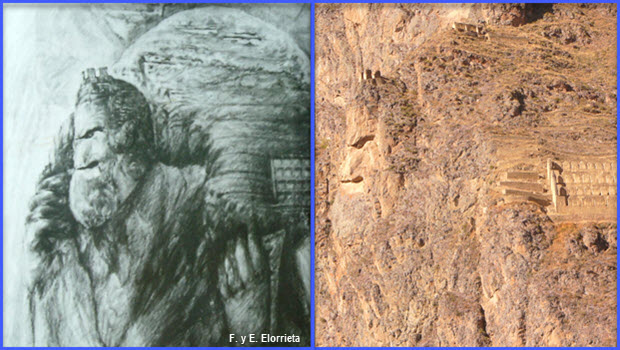
Is that the Inca Creator God you see in the cliffs overlooking Ollantaytambo?
The face seen in profile in the cliffs of the Pinculluna mountain above Ollantaytambo is said to be that of the creator God, Wiracocha. Oh yeah, says who?
Well, probably a majority of the tour guides who escort visitors through the sprawling temple fortress.
But was this always so? In fact, no, not really.
Comb through the collected works of the best-known explorers, historians and archaeologists who described Ollantaytambo in detail going back 167 years:
Francis de Castelnau (1851), Ephraim Squier (1877), Charles Wiener (1875), Antonio Raimondi (1864), Ernest Middendorff (1885), Antonio Lorena (1909), José Gabriel CosÃo (1924), Hiram Bingham or O.F. Cook (1916), Luis A. Llanos (1936), Ubbelohdy Doering (1941), Emilio Harth-Terré (1934,1943, 1947, 1965), Luis A. Pardo (1937, 1946, 1957), Antonio Astete Abril (1952), J. Ogden Outwatter Jr. (1959, 1978), Juan de Dios Yábar Pacheco (1970), Ann Kendall (1976), Victor Angles Vargas (1988), Jean-Pierre Protzen (1985, 1991, 1993).
Before the 1990s, you would be hard pressed to find any mention of Wiracocha, or any of the alternative names and spellings for the creator deity looming from the mountainside over this historic Inca settlement and ceremonial site. Not Tunupa, no Viracocha, nor Apu Qun Tiqsi Wiraqutra. Not a single Kon-Tiki.
The face of Wiracocha was pointed out to me by a guide the first time I visited Ollantaytambo in 1997. She held in her hands a recently-published book, The Sacred Valley of the Incas: Myths and Symbols by brothers Fernando and Edgar Elorrieta (1995).
This is a book you’ll see so many guides using today as a reference as they take visitors through the Sacred Valley.
I remember I bought a copy in 1997, and found it a hugely entertaining read. It ties together Andean mythology, solar alignments and is chock full of illustrations to make a case for mystic images and hidden iconography contained in the megalithic architecture and surrounding landscapes of Inca and pre-Inca sites.
The Elorrieta brothers identify, among other things, a lizard, two pumas (one upright, one crouching), and a cosmic bird at Machu Picchu; a flying condor at Pisaq; a guanaco at Tiwanaku; and at Ollantaytambo, a condor, a sacred tree, two llamas, a corn cob and, most impressively, Wiracocha.
I never thought to scrutinize too closely their interpretation.
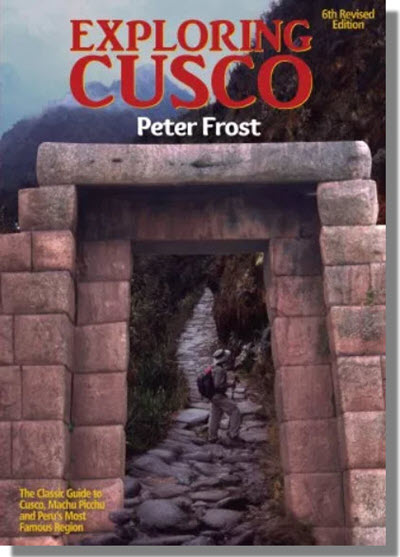
There is another book, which I cannot recommend highly enough, Exploring Cusco by Peter Frost. It has just been released in a 6th revised edition. Frost, in the politest, low-key manner, notes that it has “become fashionable, almost dominant” to interpret that craggy rock formation at Ollantaytambo as representative of Wiracocha.
“While Elorrieta’s book offers some interesting observations concerning solar alignments and man-made features,” Frost writes, “the grand overarching symbolic scheme proposed here seems fanciful to this author.”
“Fanciful” is arguably an understatement. But I’m no iconoclast.
As is often the case when I read Peter Frost’s writing, my interest was piqued. So I went searching for any scholarly reference I could find to Wiracocha and the mountainside of Pinculluna.
And I found one!
In a paper by Hernà n Amat Olazà bal published in 1994, Arqueologia y Etnohistoria de Ollantaytambo, there is a citation of a “little-known passage” in the chronicles of the Augustinian friar Antonio de la Calancha (1584—1684).
“He says that the first survivor of the deluge was Wiracocha or the Tunupa of the Titicaca highlands, ‘that those of the provinces of Cuzco recognized him as his Father, his father and his God, and that he appeared in Tambo, a town next to Cuzco, and that he went out through a window, and became a stone to which they made great veneration‘ (Calancha, 1974: I, 210).”
“Later on, Calancha says that the tradition of those of Cuzco and Tambo reported that Manco Cápac had founded the first town in Tambo,” Olazà bal continues.
And then Olazà bal poses the question, “The image of a long-lived human head that stands on the slope of Pinculluna, would it not be the perpetuation of that primal personage who ‘had divided the world into four parts’?”
That’s the one reference I found.
Some background: Manco Cápac, the mythical son of the sun god Inti and the progenitor of the Inca dynasty, came nine generations before Inca Pachacutec, the historical ruler whose royal estates included Ollantaytambo. He died around 1471.
Four generations after him came Manco Inca Yupanqui, who was installed by the Conquistador Francisco Pizarro, but then revolted against the Spaniards in 1536.
The Inca’s only outright victory over the Conquistadores occurred during that prolonged rebellion in 1537 at, or very near, Ollantaytambo. (If you want to read about it, again, I can’t recommend Exploring Cusco highly enough.) Soon thereafter, Manco established the Neo-Inca State in a jungle refuge, Vilcabamba, beyond the immediate reach of the Spaniards.
In 1539, Pizarro sent forces into Vilcabamba to try to capture him. That primary mission didn’t work, but the endeavor was far from a failure.
To quote Exploring Cusco:
“The campaign had been a qualified success; the Spaniards had not succeeded in capturing Manco Inca, but they had loot, and they had with them the captive Coya, Cura Ocllo, wife and sister of Manco Inca. Francisco Pizarro himself arrived on the scene, hoping to negotiate Manco’s surrender. When Manco refused to negotiate Pizarro vented his anger on Cura Ocllo. She was stripped naked, flogged and then killed with arrows. So that Manco should understand fully what had happened, Pizarro had her body tied to a raft and floated down the Urubamba to be discovered by the Inca’s men downstream.”
Now, we can’t know for sure whether those Inca troops venerated the mountain image of Wiracocha before they went into battle in 1537. Nor could anyone say whether Cura Ocllo peered up to the deity two years later as the Spanish archers took aim.
But we can say with certainty that thousands of tourists do so now.
There is no argument, it is an iconic view and makes for a spectacular photo.
Are you interested in a private tour of the Sacred Valley and Ollantaytambo?
Just reach out to us through Whatsapp or our Contact Us form.
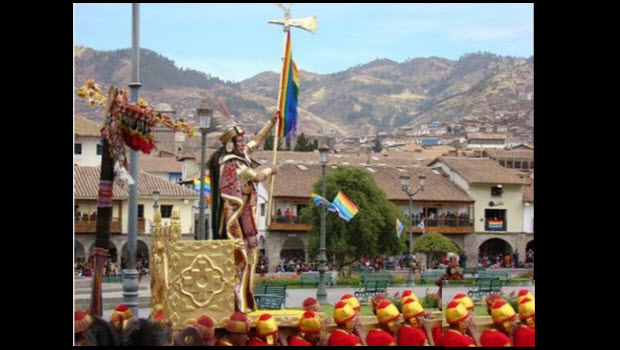 Book your Cusco trip featuring the Inti Raymi Festival
Book your Cusco trip featuring the Inti Raymi Festival 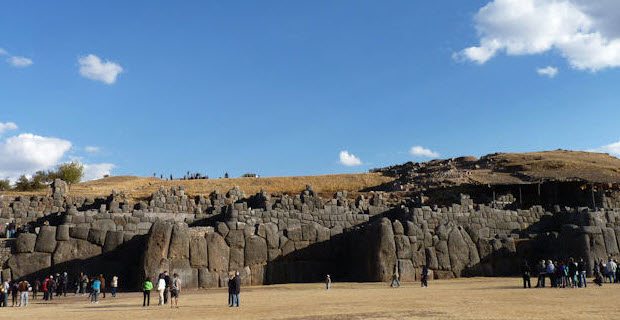 The virtual reality of Inca architecture: Sacsayhuaman
The virtual reality of Inca architecture: Sacsayhuaman 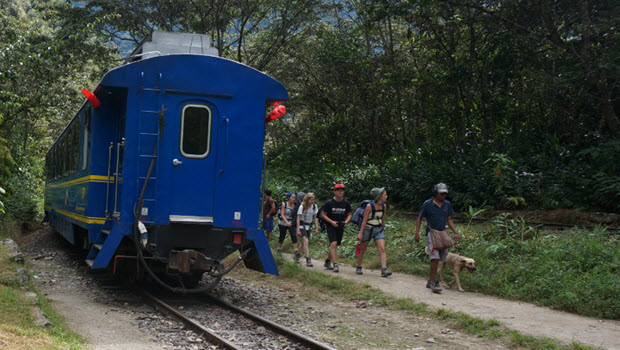 Regulating the back door entrance to Machu Picchu
Regulating the back door entrance to Machu Picchu 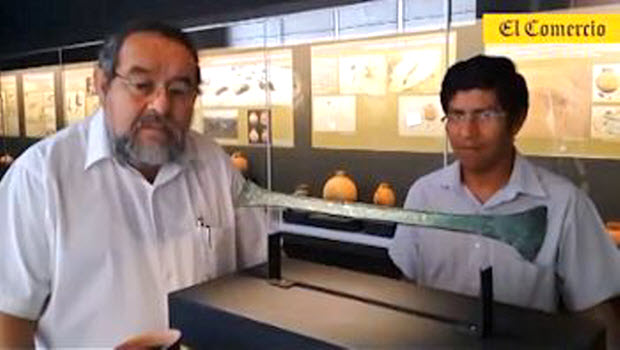 Free exhibit of ancient artifacts from El Chorro tombs
Free exhibit of ancient artifacts from El Chorro tombs 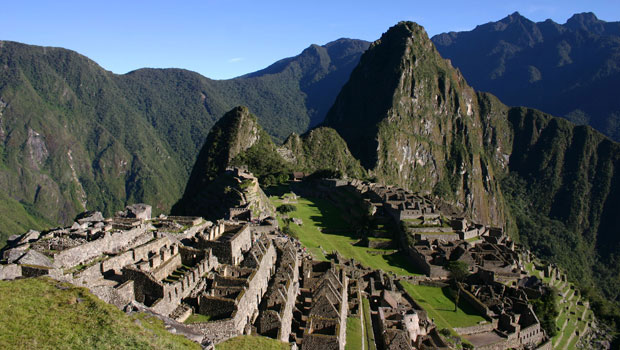 Mandatory tour guides and fixed routes coming soon for Machu Picchu
Mandatory tour guides and fixed routes coming soon for Machu Picchu 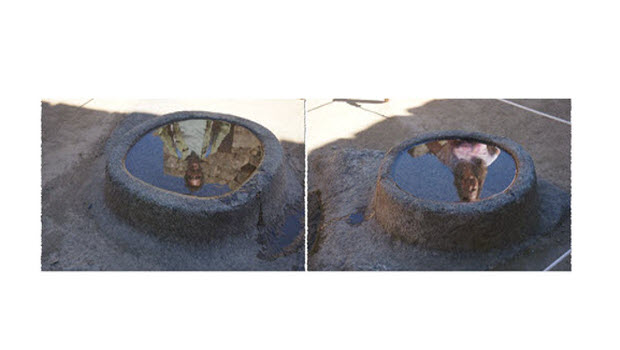 See yourself in the star mirrors of Machu Picchu
See yourself in the star mirrors of Machu Picchu 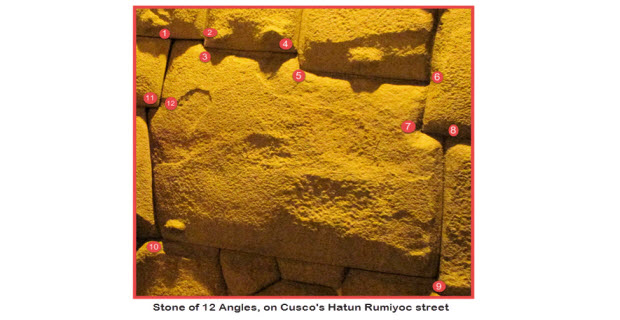 Famous 12 angle Inca stone topped but not overshadowed by 13 angle stone
Famous 12 angle Inca stone topped but not overshadowed by 13 angle stone 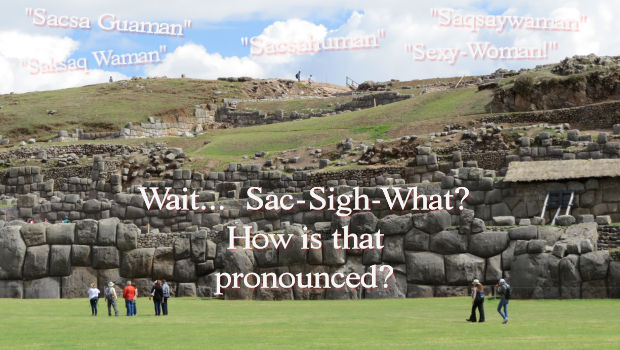 How to pronounce the name of that awesome ruins above Cusco
How to pronounce the name of that awesome ruins above Cusco
The Inkas are masters of the invisibility spell. Across the river on Bandolista is a pristine Inka town called Kuntur Punku that is loaded with several tons of gold and jewels. People stumble over it all the time but they just can’t see it. On the toe of Pinkuylluna overlooking the Hundred Windws is a rock that will, if you lay hands on it, take your mind back through time to look through the eyes of a living Inka. Archaeologists, historians, and Andeanists would give an eye for ten minutes of looking at Ollanta as it stood in 1465, but they just can’t see that rock.
The spell on Tunupa Viracocha (a natural formation BTW, not the Inka style there) wore off for a few in 1995 and the rest in Y2K.